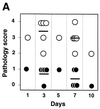Probing the function of Bordetella bronchiseptica adenylate cyclase toxin by manipulating host immunity
- PMID: 10024599
- PMCID: PMC96485
- DOI: 10.1128/IAI.67.3.1493-1500.1999
Probing the function of Bordetella bronchiseptica adenylate cyclase toxin by manipulating host immunity
Abstract
We have examined the role of adenylate cyclase-hemolysin (CyaA) by constructing an in-frame deletion in the Bordetella bronchiseptica cyaA structural gene and comparing wild-type and cyaA deletion strains in natural host infection models. Both the wild-type strain RB50 and its adenylate cyclase toxin deletion (DeltacyaA) derivative efficiently establish persistent infections in rabbits, rats, and mice following low-dose inoculation. In contrast, an inoculation protocol that seeds the lower respiratory tract revealed significant differences in bacterial numbers and in polymorphonuclear neutrophil recruitment in the lungs from days 5 to 12 postinoculation. We next explored the effects of disarming specific aspects of the immune system on the relative phenotypes of wild-type and DeltacyaA bacteria. SCID, SCID-beige, or RAG-1(-/-) mice succumbed to lethal systemic infection following high- or low-dose intranasal inoculation with the wild-type strain but not the DeltacyaA mutant. Mice rendered neutropenic by treatment with cyclophosphamide or by knockout mutation in the granulocyte colony-stimulating factor locus were highly susceptible to lethal infection by either wild-type or DeltacyaA strains. These results reveal the significant role played by neutrophils early in B. bronchiseptica infection and by acquired immunity at later time points and suggest that phagocytic cells are a primary in vivo target of the Bordetella adenylate cyclase toxin.
Figures











References
-
- Akerley B J, Cotter P A, Miller J F. Ectopic expression of the flagellar regulon alters development of the Bordetella-host interaction. Cell. 1995;80:611–620. - PubMed
-
- Betsou F, Sismeiro O, Danchin A, Guiso N. Cloning and sequence of the Bordetella bronchiseptica adenylate cyclase-hemolysin-encoding gene: comparison with the Bordetella pertussis gene. Gene. 1995;162:165–166. - PubMed
-
- Confer D L, Eaton J W. Phagocyte impotence caused by an invasive bacterial adenylate cyclase. Science. 1982;217:948–950. - PubMed
Publication types
MeSH terms
Substances
Grants and funding
LinkOut - more resources
Full Text Sources
Other Literature Sources

